|
Hello Readers!
We all know that Perry used to be a small town, built up around the railroad. Many towns sprang up around the tracks of the railroad, are plenty of them survived until today. However, did you know that there used to be another town quite close to Perry, and that its name was Angus? Angus was a coal-mining town that was about four miles northwest of Perry. It served as a terminal for the M. & St. L. Railroad, which was the Minneapolis and St. Louis Railway. Now Angus used to be a thriving little town in the late 1800s. From what I have heard, it grew rapidly, even to the point where it used to be a bigger town than Perry (in the 1800s). A lot of this growth centered on the coal mine, as you may have guessed which I believe was the Mc Elheney Strip Mine. Of course, the entire town was not just about the mine. For example, one part of the town was called “Whisky Row”. All of the bars were in this part of town, and there are plenty of fun stories involved with it. My favorite that I have heard is about the law enforcement around these bars. Apparently Angus was a town that sat on the line between two counties, and Whiskey Row was right were this line was located. According to the stories, if someone got into trouble with the law at the bar, there was an easy way to get out of trouble. They could simply step to the other side of the bar, since it was in a different county, and had different jurisdiction! Now I am sure this did not work exactly as it sounds, but it is a fun little story. Unfortunately, Angus was not to last. By the early 1920s, the town had started to die out. The reason why it started to die out it is simple: the mines started to close. Without the mines, Angus could not support itself, and many of the people moved to Perry. Now there is not much left to Angus, but there is a plaque marking its location. If you have time, do not hesitate to go look at the plaque, or come by Hometown Heritage to see some of the photos. We have a lot more photos than just what I have put here!
1 Comment
Hello Readers! To a lot of us, Perry seems like a small, innocent little town. However, Perry is not quite as innocent as it seems. There was once a time when Perry was a hub for things that were far from innocent. Let me tell you of a story of one such time. The year was 1923 and a big group of people had gathered in Perry. Most of them were dressed in white, but not everyone belonged to the same group. The first group of people were Nurses and Sisters, who had come to oppose the second group. The second group, supposedly composed of mostly men, were members of the Ku Klux Klan. Charolette Kaster, who donated a photo of the event to us, also gave us a brief history of the event, as told by her grandmother. It is as follows: “The KKK came to Perry in about 1923. In addition to motivational speakers, there were a group of "thugs" from out-of-town who had come to organize Perry and promote their organization. Some in Perry resisted, and were threatened with burning of homes and businesses if they did not participate. The first meeting was a large crowd, many of whom were curiosity seekers rather than Klan followers. There were some number of men who donned the white robes and hats/masks, whether by belief or fear, only each knows for himself. There was to be a parade of the KKK during a holiday. As they lined up, these Sisters dressed in their uniforms stood forward and blocked the street. None of the Perry men would harm the Sisters, so they disbanded. They did meet later that night, burned a cross in someone's farm field, but nothing further came of it. It was the beginning of the end for the KKK in Perry.” There are a few other stories about the KKK and the march that they held here in Perry. One quote, which we believe is from George Soumas, talks about how his father knew who people were in the march because he could recognize their shoes. According to other photos we have in our catalog, the KKK also had a building in town that they used for meetings and parties, according to the photo. We even have a Perry Chief article about the march, which you can come and see in the database here in the Town Craft building. The most interesting thing that we have in our archives from the dealings of the KKK here in Perry, however, is an actual outfit worn by a member, complete with the hood. As you can see, Perry is not quite the innocent town that it may appear. There are plenty of other stories about the KKK’s dealings in Perry, but you will have to go out and discover them for yourself. Hello Readers,
Sorry for the late post this week, we are rather busy here at Hometown Heritage as of late. However, there is something interesting that I would like to share with all of you. First, let me ask you this question: have you ever wondered if you, or someone you know, appeared in one of the Perry Newspapers? Well, all of us here at Hometown Heritage are excited to tell you that now, you can find out! We have recently installed on our public research station a database of all the Perry Newspapers that have ever existed from 1874 to 2013. Not only do we have this database, but it is also super simple to search! So now you can find out if you have ever appeared in The Perry Chief, or any of the other local publications. Or, perhaps you have wondered what was happening on this day 100 years ago? The database can do that as well! The database is a wonderful tool, and we are very lucky to have it. All of this is possible thanks to Mary Murphy and the Perry Public Library. They were the ones who put in the hard work to create this database, and then shared it with us. For this reason, we would like to extend a big thank you to Mary and the Perry Public Library! I highly encourage anyone to come down either to Hometown Heritage in the Town Craft Building (see the below map if you do not know where we are), where we have this database on our public research computer, or to the library to have a look at the database, and conduct a search for their own name. Not only could you find something interesting in the database, but there is plenty of fun and exciting things here at Hometown Heritage as well. Plus, it gets a little lonely down here. So please, do not hesitate to come down and take a look! Good Afternoon readers!
Today, instead of talking about something that we have here at Hometown Heritage, I am going to tell you about a building that many of you have probably seen here in Perry. The building in question is the Jones building. This building is behind Fareway, and has the word “Jones” carved across the top. Currently, the Jones building functions as a group of apartments. However, people did not always live in the building. So let us learn about the buildings history! Before we can learn about what the original use of the building, it is important to learn about the man who built it. A man named C. Durant Jones is behind the creation of the building. He had a wife named Ida, and two kids named Horton and Lois. Jones was also a man of many talents. He was a newspaper publisher, a writer, a minister, a politician, a lecturer, a businessman, a temperance leader, a builder and contractor, a realtor, and a one point he was even the mayor. He also owned and operated the Jones Business College and a cement plant. Jones resided in Perry from 1904 to 1928, before he moved to Texas and hosted a radio show there. Now, onto the building itself. Construction of the Jones building occurred between 1912 and 1913 by C. Durant Jones. He used reinforced concrete for the outside (which came from his own cement plant of course), and oak for the interior. However, how did people use this building when it C. Durant Jones first built it? Well, the first floor housed offices for the Chautauqua, and, maybe you guessed it, a college occupied rest of building. This college was the Jones Business College. The college did not last long, however, and it closed after 1921 and the building converted to apartments. Now, many of you may be wondering what the Chautauqua is, since it was part of the building. I do not know much about it myself, but we do have a book about it here at Hometown Heritage. From what I can gather, the Chautauqua was a movement that started in the small town of Chautauqua, New York. A Methodist Episcopal minister started it along with an inventor named Lewis Miller. Chautauqua was, and still is, an educational movement, encouraging adults to continue learning and growing everyday of their lives. C. Durant Jones was a big supporter of this, and so he built the building not only as a college to continue people’s education, but also as a building to house the Chautauqua movement, which he organized in Perry in 1910 and incorporated in 1912. So now you know all about the Jones building! Next time you happen by it, perhaps when you are buying food from Fareway, take a moment to remember what it stands for, and try to keep learning new things every day. 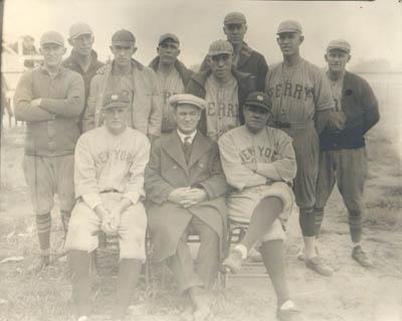 Bob Meusel, Front Left, and Babe Ruth, Front Right Bob Meusel, Front Left, and Babe Ruth, Front Right Hello Readers! (And sports fans!) Have you ever wondered if any famous athletes have come to little old Perry, Iowa? Well, hold on to your stadium hot dogs, because I have quite the story for you! Long ago, on an October day in 1922, Perry faced Pella in a good old-fashioned baseball game. The weather did not exactly co-operate. Everyone was worried about the game being rained out, a problem that is all too common today as well. Eventually, the game did start, and the athletes played it just like any other game. Each team took their turn, and at the end of the day, Perry won the game with a score of twelve, while Pella only had a score of four. So far, this all sounds like the average baseball game and not anything interesting at all. However, here is where this story gets amazing! Thanks to the American Legion, who paid what I can only assume was a decent amount of money, both Perry and Pella had a special member on their team: Perry had Babe Ruth, and Pella had Bob Meusel! That is right, Perry once hosted the world famous Babe Ruth thanks to the hard work and contributions of the American Legion. Not only did he come and play for the Perry team, he also stayed at the Hotel Pattee, along with Bob Meusel. In fact, if you every have the chance to stay at the Hotel Pattee, there is a photo of Babe and Bob in the bowling alley on the lower level. Most of this information comes from a very old Perry Chief. It took quite a while for me to find it, since we keep old scans of different Perry newspapers on microfilm (and I misread the dates at first as well, oops!). Still, there are many interesting things in the old newspapers. If you ever have the chance, look over some of the old newspapers you may have lying around. Not only is there bound to be some interesting stories, but also just the advertisements can hold some value and entertainment. I saw one while I was looking about a quote "swaggerest" (the ad actually uses this made-up word) villain. That, however, is a story for a different day. 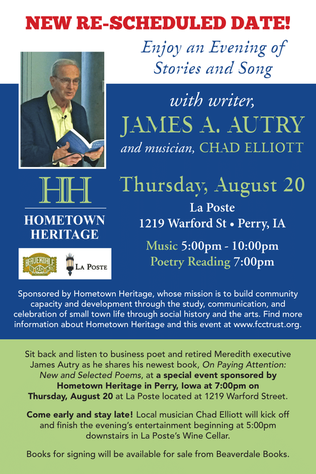 Hello Readers! Today will be a short blog post. I just wanted to remind you all that tomorrow, August 20th, Jim Autry will be reading from his new book On Paying Attention: New and Selected Poems. He will be reading at 7:00pm at La Poste (La Poste is located at 1219 Warford Street, Perry, Iowa). Jim Autry is a retired Meredith executive who has become a business poet. Beaverdale Books will also be selling his book, so you can come and your own personal copy, and then have it signed by Jim Autry! In addition, musician Chad Elliot will also be performing that night, starting at 5:00pm. He will be playing until 10:00pm, so come early, and stay late! Yet another point of interest at La Poste tomorrow night is the 38th Annual Iowa Watercolor Society Exhibition. They will be displaying 90 great watercolors for everyone to enjoy. These paintings will be at La Poste until September 24 if you want to see them but cannot make tomorrow. If all of these things were not enough to win you over, La Poste will also be serving food! A meal of a smoked rib eye sandwich, potato salad and chips is only ten dollars. There will also be cellar and gallery drink specials available. In fact, tomorrow night is also Handlebar Happy Hour! All in all, tomorrow night is going to be a lot of fun. I highly encourage you all to come, and hope to see you there! Salvēte (that is Latin for welcome!) readers!
Today, we are going to start a new kind of series of blog posts about something different. Normally, we would be talking about something that is interesting, or has some kind of mysterious story behind it. Starting with this post, however, we are going to be talking about some of the more ridiculous items in the collection here at Hometown Heritage. Now without sounding too offensive, these are the kinds of items that, when I first saw them, I questioned why they were actually in our collection. If you do not agree with what I think is questionable, please leave a comment and explain why! First up on the list of not-so-interesting items is a blank piece of paper. Upon first glance, this single piece of paper seems like it has no business being in our collection at all. It has nothing written on it, and there appears to be no historical value in keeping it. In fact, it looks like the kind of thing that one would toss into the trash without a second thought. However, something may make this piece of paper worth keeping: the header. Printed at the top of this piece of paper is “Hoagland Grocery Co.” and a few other things, such as the names Clyde R. Hoagland and Harry T. Hoagland. The reason this may make this piece of paper worth keeping is that Hoagland Grocery was an early grocery in Perry. It would be worthwhile to keep important documents and information about this early part of Perry’s history. That said, however, a blank charge slip from the grocery is not really an important document, nor does it reveal any important information. This comes back to something that we have talked about before on this blog: it is important to tell the younger generations the stories behind the things that you keep. For all I know, this blank piece of paper could actually be the last charge slip ever made for Hoagland Grocery. Or it could be the first one that was ever made! If this piece of paper had retained its story, it could be an amazing piece of history worth keeping in our collection. Now, however, people of my generation simply see it as something that we can toss into the trash, even if it should not be. To prevent this from happening, if any of you have information regarding this piece of paper or even Hoagland Grocery Co., plus come forward and tell us! We would be more than happy to record it so that others can remember it too. Before I go, since this is going to be an ongoing group of blog posts, I have decided to give them the title "Scraps of the Past". This is due to most of them being "scraps" of things that may have been worth keeping at one point in time, but appear to have no value now.  Welcome back readers! Now, we have talked about animals on this blog once before, and that was a very interesting day. I thought that nothing out here could ever beat the wonder and curiosity that the shoulder chicken inspired in me. However, I was wrong. There is something more wonderful and curious than the shoulder chicken, and that animal is the wagon ostrich. The wagon ostrich is exactly what it sounds like. It is an ostrich, hitched to a wagon, as if that was completely normal. There is even a woman sitting on the wagon, holding the reins in her hands. That is completely amazing. I can only imagine how hard it would be to hitch an ostrich to a wagon. It seems highly unlikely to me that an ostrich would cooperate with anyone trying to do that to it. In addition, there is a fenced off area behind the wagon with a whole group of ostriches in it. Are they all wagon ostriches? Is this a family business for those ostriches? This, along with the fact that the side of the wagon reads “Los Angeles Ostrich Farm”, leads one to believe that this is some kind of tourist attraction. However, what is also of interest is why this photo is in our system. Now the details of this photo are not very plentiful. Really, all that I know comes from the title: “Kate Friedrichsen in a Wagon Pulled by an Ostrich”. What exactly does this mean? Is Kate Friedrichsen the owner of the ostrich farm? Maybe she is a tourist who stopped by and got a ride. Neither of these answers really explain why we have this photo. This question is even more curious because based on the photo. From what we can see, this wagon is in Los Angeles, or at least comes from Los Angeles. Now correct me if I am wrong, but Los Angeles does not have very much to do with little old Perry, Iowa. They are half a continent away from each other after all. The only connection that I can think of is that, perhaps, this is how Kate Friedrichsen got from Los Angeles to Perry. Perhaps she rode the entire way on a wagon drawn by an ostrich. That would be a completely new level of dedication. I doubt that I could ride in a wagon that far, let alone in a wagon drawn by an ostrich. Of course, it would also require a team of ostriches, since one is probably not strong enough to pull a wagon full of stuff. Overall, even if the reason that it is in our collection is unknown, it is still an amazing photo. If you have any amazing photos in your photo collections, please feel free to share! 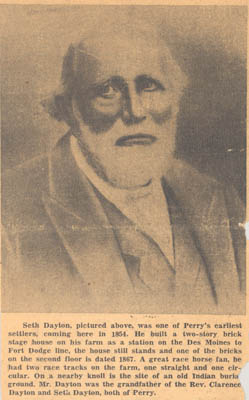 Hello Readers! The past couple of times I have come to you all with a mystery stemming from the lack of information in our system. However, that is not the case today! I have actually found something in our system that not only has information, but I would even say that it has an over-abundance of information. Because of this, today I will be telling you all about Seth Dayton, and his interesting, fun, somewhat unfortunate life. Seth Dayton was an early settler of Perry in 1854. He built his own brick house on Lake Robbins Road that also served as stagecoach station on the Des Moines to Fort Dodge line. The house was two stories, so Mr. Dayton probably had a fair amount of money to his name. He was married twice, and had nine children in total, three with his first wife and six with his second. So far, it seems like Seth had a pretty normal life for an early settler. However, his story quickly becomes very interesting. Let us start with his nine children. Now having nine children is not a surprising detail about an early settler, since families often needed as much help as they could get around the house and farm. The names of his first three children were Ellen, Frank, and Isabelle, and the names of five of his other children were Harry, Adeline, Eva, Jane, and Minnie. All of these names are, without trying to sound mean, common for the time and do not seem very interesting. It is his last son that has a name that stands out from the rest: Pharaoh Israel “Fez”. This name is amazingly unique. There are few people that I know of who are named Pharaoh (aside from all of the Pharaohs of Ancient Egypt), and even less people who have the nickname “Fez”. Unfortunately, there is little else to say about Pharaoh, since the article in our system is about his father and not him. Yet Seth Dayton’s family is not the only part of his life that is noteworthy. His house, aside from what I have already told you, is also very interesting. First, according to the article, Seth was a great horse race fan, and because of this, he had two horse race tracks next to his house. These tracks would get him in some big trouble later in life. According to the information in our system, he lost his farm because of horse racing: he actually bet it on a race and lost. This may not be the only reason that he lost his farm, however. According to the newspaper clipping, Seth had also built his house next to a knoll that was the site of an old Native American burial ground. I hope that I do not have to explain why this could be a problem (think Pet Sematary and the Poltergeist). It may even be possible that losing the farm in a bet was actually a good thing for the Dayton family: maybe they desperately wanted to get away from what they thought was a haunted house and farm. What about you, readers? Have any of you ever thought that you lived in a haunted house, and would do anything to fix it or leave the house? If you have, leave a comment in the space below! In addition, the house itself is still standing and is even being restored. If you want to learn more about the house, you can go to the Dallas County Conservation site by clicking here, or even drive out to see it for yourself! 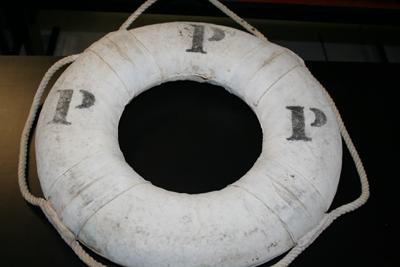 Greetings, readers! Today is another mystery, just like the one about the shoulder chicken. However, today’s mystery is about boats. Yes, that is right, boats. Now we do not actually have any boats here at Hometown Heritage (where would we put it, after all), but we do have something from a boat: an old life preserver (or life buoy). Glenn Theulen donated this ring, and as you can see in the picture, it was white with three P’s on it. Here lies part of the mystery. What do the three P’s stand for? Peace, Perseverance, and Patience? Or maybe Partying, Poker, and Pajamas? Unfortunately, searching Google for “PPP life preserver” only brings up a life jacket product… for dogs. What do you all think that the three P’s stand for? Contemplating the problem it seems the two most likely things that they stand for is either the name of an association or company that distributed this life preserver, or the name of the boat that it belonged too. This brings to light the second mystery of this object: where did it come from? Now obviously this came from a boat (I am not THAT silly) but where was that boat? Here in Perry there are not exactly many places to go sailing. The closest place in Perry that would count as a body of water is Frog Creek, and I highly doubt one could put a standard sized boat into that little stream. There are a few other places nearby, like Saylorville Lake or Lake Panorama, but I am not sure that a boat with this kind of life preserver would be sailing around those lakes. It seems likely to me that this life preserver belongs to a boat that was sailing somewhere out in the ocean. Maybe it was some kind of Navy boat that was used during a war? Or maybe it was just an old sailing boat, used during a vacation on the beach? Unfortunately, the answer is unknown. Once again, there is not enough information in our system here to answer these questions. If you have any answers about this life preserver (or just ideas in general) I would be very happy to hear them so that this mystery can be solved! |
Archives
March 2020
Categories
All
|
All Rights Reserved, Fullhart Carnegie Charitable Trust, 2014-2023
This website is possible with the support of the
Dallas County Foundation
This website is possible with the support of the
Dallas County Foundation

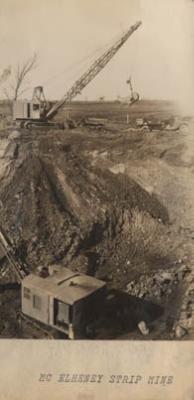
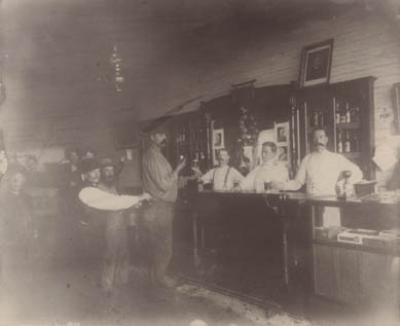
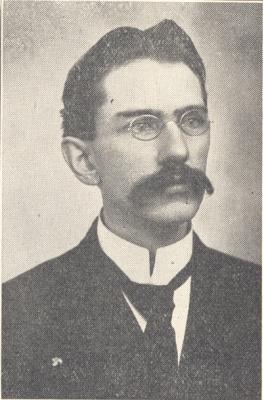
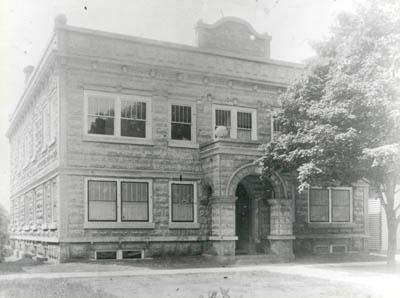
 RSS Feed
RSS Feed